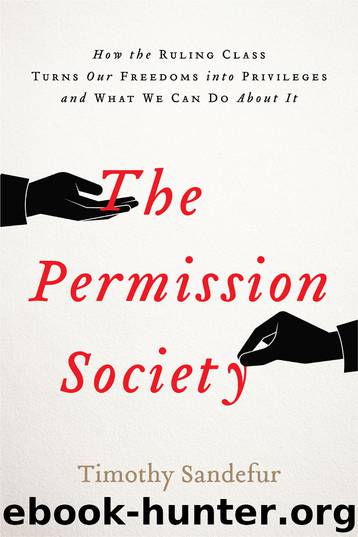The Permission Society by Timothy Sandefur

Author:Timothy Sandefur
Language: eng
Format: epub, azw3
ISBN: 9781594038402
Publisher: Encounter Books
Published: 2016-08-01T16:00:00+00:00
“Rational” Planning
Advocates of zoning generally argue that such rules are needed to protect the public from incompatible land uses – to ensure that cities are rationally planned and not constructed haphazardly. As Justice Sutherland memorably phrased it in the Euclid decision, nobody wants “a pig in the parlor instead of the barnyard,”19 and nobody wants a glue factory in a residential neighborhood.
In reality, different people have different needs and different tastes, and what might seem absurd to some people might seem reasonable to others. Allowing government planners to determine what property uses should be allowed and what should not is a recipe not only for discrimination along race and class lines, but also for arbitrary and even corrupt decision-making as well. And because a dynamic economy is always changing, often unpredictably, rules that force property owners to get government permission before they can use their property often retard progress and disrupt economic growth.
Zoning laws are inherently inflexible, one-size-fits-all rules. Knowing that such rules cannot possibly work, zoning boards typically allow for variances or other exceptions that let people use their property in ways that would otherwise be illegal. Also, local governments often enforce zoning restrictions haphazardly, forcing some property owners to comply strictly with the letter of the law and allowing other infractions to slide.
Anyone who thinks that zoning ensures rational planning only needs to take a look at the New York City zoning code.20 The Big Apple was the first city in the United States to adopt comprehensive zoning. A century later, the city’s zoning rules take up more than 3,376 pages, covering such picayune details as section 133-32(d)(1), which mandates that seating in the public areas of the Special Southern Roosevelt Island District be between 16 and 20 inches above the level of the adjacent walking surface. The New York zoning map, meanwhile, is a crazy quilt of land use designations, pockmarked with variances, exceptions, and subcategories. Forty percent of buildings in Manhattan have some sort of variance.21 Today, land use in the city is just as diverse as it ever was – except that now, exemptions are based on political considerations rather than economic ones.
“The complexity of zoning laws means more power for regulators,” wrote law professor Bernard Siegan, who until his death in 2006 was among the nation’s leading experts on the subject. “[T]he length and cost of the process gives zoning regulators enormous discretion in determining land plans, building designs, and building materials.... Fighting city hall is very expensive, and developers must necessarily limit such activity if they are to stay in business.”22
Siegan rose to prominence in 1972 with a breakthrough study of Houston, the only major American city without zoning. The lack of such laws had not brought about any sort of chaos, he argued. Incompatible uses were no more common there than in major cities that do have zoning. There were no dynamite factories located next to schools.
The explanation was simple: Houston does have land use controls, just of a different kind. Decisions
Download
This site does not store any files on its server. We only index and link to content provided by other sites. Please contact the content providers to delete copyright contents if any and email us, we'll remove relevant links or contents immediately.
International Integration of the Brazilian Economy by Elias C. Grivoyannis(98979)
The Radium Girls by Kate Moore(11973)
Turbulence by E. J. Noyes(7978)
Nudge - Improving Decisions about Health, Wealth, and Happiness by Thaler Sunstein(7657)
The Black Swan by Nassim Nicholas Taleb(7056)
Rich Dad Poor Dad by Robert T. Kiyosaki(6513)
Pioneering Portfolio Management by David F. Swensen(6256)
Man-made Catastrophes and Risk Information Concealment by Dmitry Chernov & Didier Sornette(5956)
Zero to One by Peter Thiel(5732)
Secrecy World by Jake Bernstein(4700)
Millionaire: The Philanderer, Gambler, and Duelist Who Invented Modern Finance by Janet Gleeson(4421)
The Age of Surveillance Capitalism by Shoshana Zuboff(4245)
Skin in the Game by Nassim Nicholas Taleb(4203)
Bullshit Jobs by David Graeber(4140)
The Money Culture by Michael Lewis(4134)
Skin in the Game: Hidden Asymmetries in Daily Life by Nassim Nicholas Taleb(3961)
The Dhandho Investor by Mohnish Pabrai(3722)
The Wisdom of Finance by Mihir Desai(3694)
Blockchain Basics by Daniel Drescher(3540)
